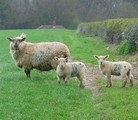Scottish sheep producers borrow hard

The level of borrowing by Scottish sheep producers soared by 30% in October this year as the sector struggled with cash-flow problems, according to Jimmy McLean, head of agricultural services at RBS.
The industry is looking at lamb prices down 20-25% on the year, said Mr McLean, who warned this could amount to a cost of £30 million in lost income to the sector.
“We estimate only 3-5% of Scottish agricultural borrowing resides in the sheep sector but in October we loaned 30% more to the sheep sector than we did the year before.
“That is a measure of the additional support we were providing at that time,” said Mr McLean.
Current levels of overall borrowing in Scotland are up by 4% to the end of September, with total level of borrowing around £1.3-£1.4bn, he said.
This will be reduced by the £300m in Single Farm Payments paid to Scottish farmers in the past week.
Future prices
By the end of this month 80-90% of recipients will have received their full single farm payment, said Mr McLean.
Additionally, 11,600 sheep farmers are this week scheduled to receive their special ewe compensation payment of £6/head to offset losses incurred this year as a result of the FMD outbreak in England.
There is, he said, relative stability in the cattle and pig sectors, although their margins are being eroded by high feed costs, up 50-60% on a year ago.
“Futures prices for wheat are pushing up again. A week ago we were talking about futures for November 2008 of £120/tonne, this week we are seeing these at £137 so the market is firming again,” said Mr McLean.
And he emphasised relatively few farmers have enjoyed the “headline prices”, which saw wheat close to £200 per tonne and the very best malting barley reach £210 per tonne, because the bulk of the grain had been sold on forward contracts.
Improved returns have triggered reinvestment in the arable sector with tractor sales up 15% year on year and Mr McLean said the past year has shown how quickly things can change in the industry.
“The future will be challenging – but we should be encouraged by the increasing demands we are beginning to see for the products derived from agriculture,” he said.
